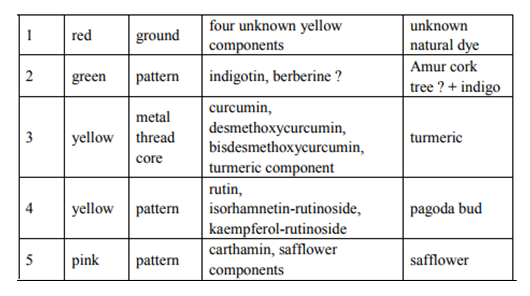V&A T.187-1948, Woman's robe of weft-pattern woven silk, China (early 18th century)
Artifact Information
The robe is made of gauze-banded plain weave silk with embroidery. This robe is a woman's garment that may be the earliest non-ecclesiastical Chinese garment in the Museum. The grand is a rich red silk that has horizontal bands of fruiting pomegranates (symbolizing a woman with many kids) in gauze weave running across the fabric at widely spaced intervals. Over this, there is shiny embroidered decoration of fruits, flowers, birds and mythical beasts [1].
Victoria and Albert Museum, London, UK T.187-1948
Summary of results
Traditionally used Chinese dyes, pagoda tree buds, turmeric and safflower had been identified as the dyeing sources of this Chinese woman's robe [2]. Berberine was found in sample 2, a green thread from the pattern. Quite a few plants can generate berberine as a yellow dye [3]. The most widely used were Phellodenrom spices, for exampleAmer cork tree and Chuan Huang Bo (Huangbo from Sichuan).
References
[1] https://collections.vam.ac.uk/item/O72026/robe-unknown/
[2] Jing Han, The Historical and chemical investigation of dyes in high status Chinese costume and textiles of the Ming and Qing Dynasties (1368-1911) PhD thesis, University of Glasgow February 2016.

